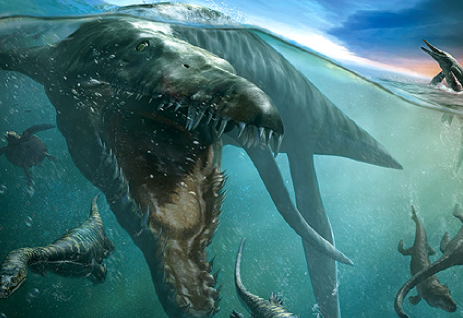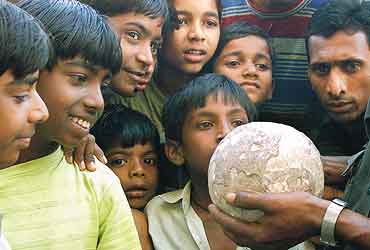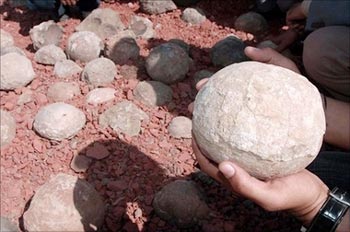
In Sanskrit 'Makara' is a word that means ‘sea dragon’ or ‘aquatic-monster,’ long thought to be a mythical creature in Hindu and Buddhist traditions. Paintings and sculptures of this fantastical creature are found in India, Nepal, Sri Lanka, Burma, Thailand, Cambodia, Malaysia, Indonesia, Vietnam, China and Japan — practically everywhere in Asia.


The Makara in India is known to be the vahana (vehicle) of Ganga-devi - the goddess of the river Ganges and the vahana of the god of the sea, Varuna. A Makara is also the insignia of Kamadeva (god of lust) and Kamadeva’s flag is called makara-dhvaja, a flag having the Makara drawn on it. In Hindu astrology the Makara is also the astrological sign of Capricorn. A little research reveals this strange mythical creature to have been very popular both in ancient times and in our present day. But is it mythical?

The Makara is often depicted with the head of a crocodile, horns of a goat, the body of an antelope and a snake, the tail of a fish or peacock and the feet of a panther. Varuna is said to be the only one who can control the Makara and does not fear them (save and except for Krsna that is).

In some English translations of the Gita, for simplicity of reading, ‘makara’ has been translated as shark. But it is not a shark. The Timingila that is often mentioned along with the Makara in other Vedic texts is classified as a shark – a shark of monstrous proportions. This has been discussed at length in Krsna Talk #88.
Mahabharata mentions the Timingila and Makara as being deep within the ocean, along with other huge sea creatures:
timingilah kacchapasca tatha timi timingilah
makarascatra drsyante jale magna ivadrayah
“There were seen Timingilas, tortoises, Timi-timingilas and Makaras, that were like great rocks submerged in the water.” (Mahabharata, Vana Parva. 168.3)
The Ayurvedic text of the 6th century BCE known as Susruta Samhita also lists the Timingila and Makara as being amongst the formidable species of aquatic life:
timi-timingila-kulisa-pakamatsya-nirularu
nandi-varalaka-makara-gargaraka-candraka
mahamina-rajiva prabhrtya samudrah
"The Timi, Timingila, Kulisa, Paka-matsya, Nirularu, Nandi-Varalaka, Makara, Gargaraka, Candraka, Maha-mina, and Rajiva etc, constitute the family of marine fish." (Susruta Samhita, Ch.45)
In Srimad Bhagavatam, Makaras and Timingila are mentioned as predators, attacking Markandeya Rsi:
ksut-trt-parito makarais timingilair upadruto vici-nabhasvatahatah
tamasy apare patito bhraman diso na veda kham gam ca parisramesitah
“Suffering from hunger and thirst, attacked by Makaras and Timingila and battered by the waves and the wind, Markandeya wandered through the infinite gloom that enveloped him. Overcome by exhaustion, he lost all sense of direction and could not ascertain what was the sky and what was the earth." (Bhag. 12.9.16)
Bhagavad-gita mentions the Makara in Verse 31, Chapter 10 as follows:
pavanah pavatam asmi ramah sastra-bhrtam aham
jhasanam makaras casmi srotasam asmi jahnavi
“Of purifiers I am the wind. Of the wielders of weapons I am Rama. Amongst aquatics I am the makara and of rivers I am the Ganga.”
The Makara is described in Vedic texts as half animal, half aquatic and an aggressor — a true monster of the deep. Often depicted in art as having the mouth of a crocodile, the body of a fish, the tail of a peacock and the paws of a panther, the Makara has attained mythical status.
Now the question arises – is the Makara a mythical creature or was it actually real? And if so, then how could it look like it has been depicted in art for centuries with so many different animal body parts? When one looks at recent scientific discoveries and takes into consideration a bit of ‘poetic license’ that the artist may have employed, the so-called mythical Makara becomes as real as life.

Recent discoveries in archaeology have revealed what paleontologists call a Pliosaur. The fossilized Pliosaur was found in Dorset, England in 2003 and took until 2008 to remove from the rock cliff in which it was found. Once excavated it revealed a sea monster in remarkable detail.
Scientists suspect the Pliosaur fossil is approximately 155-million-years old and lived during the Jurassic and Cretaceous Periods during which time it was one of the top predators of the oceans.
Paleontologist Richard Forrest commented to the BBC as follows: "This is an iconic specimen – one of the most exciting we have seen in years. It was probably the most fearsome predator that ever lived. Standing in front of the skull you can imagine this enormous beast staring straight back at you, fixing you with its binocular vision, and attacking. Just thinking about it raises the hairs on the back of your neck."
Dr. Forrest went on to say that the creature’s bulky body, which would have been powered through the water with four paddle-like limbs, has never been found and may not have fossilized. Scientist’s estimate based on the 2.4meter long skull, that the Pliosaur would have been 15 to 18 meters in length. Impressive indeed.




We are herein suggesting that the Pliosaur could easily be the Makara of myth, but we are not the first to equate a mysterious ocean monster to the Makara. We have also stumbled upon the reports of a creature called the Ambulocetus, a creature that could walk as well as swim. It lived during the early Eocene Period some 50 million years ago. The fossil of Ambulocetus was found on the coast of Pakistan from a time when Pakistan and India was a single island in the Indian Ocean slowly drifting toward the continental shelf of Asia. Some crypto-zoologists speculate that the Ambulocetus is a candidate for being the Makara, yet most scientists suggest that the Ambulocetus fills the evolutionary gap between aquatics and land animals.

Once, when discussing with Pusta Krsna, Srila Prabhupada commented that there is no discussion of dinosaurs in the Vedas, therefore he did not believe that they existed. Then again, Sadaputa recounts that when Prabhupada was asked about the dinosaurs he replied that they were not extinct. So which is it? Is there really no mention of dinosaurs in the Vedas, or was Prabhupada just denying scientific knowledge and discoveries because most scientists of his time were denying the Vedic knowledge? We think so.
In any case, we do find a reference to what easily could be understood to be dinosaurs in Srimad Bhagavatam when demons and demigods rode strange creatures into battle.
grdhraih kankair bakair anye syena-bhasais timingilaih
sarabhair mahisaih khadgair go-vrsair gavayarunaih
sivabhir akhubhih kecit krkalasaih sasair naraih
bastair eke krsna-sarair hamsair anye ca sukaraih
anye jala-sthala-khagaih sattvair vikrta-vigrahaih
senayor ubhayo rajan vivisus te ’grato ’gratah
“O King, some soldiers fought on the backs of vultures, eagles, ducks, hawks and bhasa birds. Some fought on the backs of timingilas, which can devour huge whales, some on the backs of sarabhas, and some on buffalo, rhinoceroses, cows, bulls, gavaya [jungle cows] and arunas. Others fought on the backs of jackals, rats, krkalasa, rabbits, human beings, goats, black deer, swans and boars. In this way, mounted on animals of the water, land and sky, including animals with deformed bodies [vikrta-vigraha], both armies faced each other and went forward.” (Bhag. 8.10.10-12 – The Battle Between the Demigods and the Demons)
Here we find a fantastical description of the vahanas used in a great battle in horary antiquity, but some of the creatures described have no English or Indo-Aryan equivalent such as bhasa, sarabhas, timingila, gavaya, arunas, krkalasa and vikrta-vigraha. So what are these creatures and why do they have no equivalent names in modern languages? Could they be extinct? Could any of these have been what we now call dinosaurs? We think so. The mere fact that the timingila is mentioned is proof enough that some of these creatures are going to be formidable predators – which ones?
Vikrta-vigraha translates as ‘animals with deformed bodies’ and krkalasa translates as ‘big lizard’. So when one’s opponent is riding a vicious animal like a rhinoceros or a timingila — then is riding an ordinary lizard into battle a good idea, even a big one? Krkalasa is a ‘big lizard’ — think dinosaur! And vikrta-vigraha are ‘animals with deformed bodies’ — think dinosaur! In any case, no vahana mentioned here could have been ordinary, – even the human vahanas must have been giants. So it is intelligent to think that if one takes these narratives to be true in the first place, then what we think of today as dinosaurs could surely be among the vahanas mentioned in Srimad Bhagavatam.
The gavaya mentioned in the above verse translates as ‘jungle cow’ and interestingly enough these ‘jungle cows’ (also known in modern Hindi as nila-gaya, blue cows) still exist in and around Vrndavana, India and, like the Makara, they have the distinct characteristic of three animals — a cow, a horse and a deer. Once seeing these strange animals there is no argument that they are a ’three in one’ creature. So why not a Makara with a mouth of a crocodile, a body of a fish, and a tail of a peacock? You just haven’t seen one yet. But it looks like the archaeologists in England are on to something with their recent discovery of the Pliosaur.

It is true that the krkalasa and bhasa are not easily equated with Tyrannosaurus Rex and Pterodactyl, but then again, why not? It seems to be a matter of putting one and one together and moving on.
Yes – there were dinosaurs mentioned in Srimad Bhagavatam and possibly other places in the vast Vedic literature. Unfortunately, it has been the thinking of some theists that the scientists have falsified dinosaur remains (“The Devil put them there”) simply to give credit to the evolutionary theory. But I think it is safe to say that such does not stand against the repeated discoveries of dinosaurs in different parts of the world and even in India.
Yes, dinosaur remains and even dinosaur eggs have been discovered in Gujarat, India (http://news.bbc.co.uk/2/hi/8671676.stm). However, when the fossilized eggs were first discovered, villagers took them home and began worshiping them as siva-lingams (typical Hindus).





When it is obvious that scientists are not running around falsifying dinosaur fossils and that dinosaurs did indeed exist in India, then it is reasonable to conclude that dinosaurs are indeed mentioned in Vedic literature and that archaeologists may have recently found the Makara in the fossil record in England.
Admittedly, the case for the Megalodon fossil being the Timingila as discussed in Krsna Talk #88 may be more convincing than that of the Pliosaur fossil being the Makara, but the later is certainly probable. Thus, it is worth reiterating a previous point regarding the age of man.
According to scientific evidence, it is estimated that the last of the Pliosaur and Megalodons lived on this planet around 1.5 million years ago or before. That is a long time ago, especially considering that the estimated age (according to science) of the first human being was only 250,000 years ago. That would mean that the Pliosaur and Megalodon became extinct 1,250,000 years before the first human being spoke a coherent language, kept records or attempted to write anything.
The Pliosaur and the Megalodon appear to be the same creatures as the Makara and the Timingila mentioned in Vedic texts. But what is so amazing or interesting about that, and what is our point?
Our point is that western scholars assert that the Bhagavatam was only written in the 9th century CE, the Ramayana in the 4th century BCE, and the Mahabharata between the 8th and 4th centuries BCE. But if this were a fact, then how did the writers of these books know about ocean-dwelling creatures, their size, their vicious aggression and their diets if those creatures had already been extinct for 1.5 million years? Bhagavatam, Ramayana and Mahabharata all mention the existence of the Makara/Pliosaur and the Timingila/Megalodon, but where did the authors get their information?
When (by scientific estimation) human beings have only been on this planet since 1,250,000 years after the Megalodon/Timingila became extinct — who told the Vedic authors about these creatures? If there were no humans present on this planet between the period when the Pliosaur and Megalodon became extinct and 250,000 years ago, how could the writers of the Vedic texts have known such things? And it is obvious that they did.
Scientists and scholars will have to ponder this question, but for us it is simple — there have always been human beings on this planet from its earliest beginnings and the knowledge of all such things has been passed down thru the ages via the disciplic succession of gurus and disciples.
